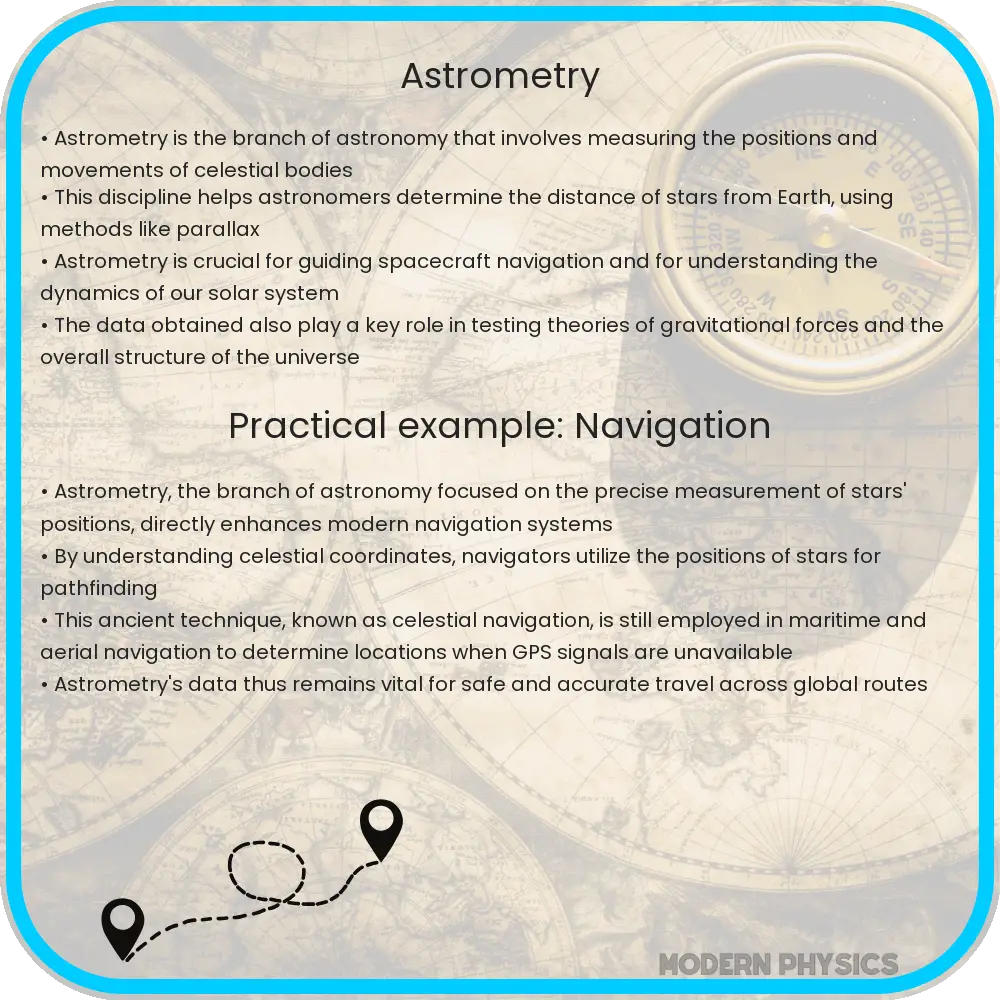Explore the science of astrometry, the precision of celestial mapping, and how it shapes our understanding of the universe, guiding future astronomical discoveries.

Astrometry: The Backbone of Celestial Mapping
Astrometry, the oldest branch of astronomy, is the science of measuring the positions, distances, and movements of stars and other celestial objects. This precision-driven field provides the fundamental framework for astronomical observations, enabling scientists to create detailed maps of the sky and understand the dynamics of the universe. Through astrometry, astronomers can decipher the mechanics of celestial bodies, contributing significantly to our understanding of the cosmos.
The Precision in Astrometry
The precision of astrometric measurements is crucial. Modern astrometry relies heavily on highly accurate techniques and instruments, such as CCDs (Charge-Coupled Devices) and VLBI (Very Long Baseline Interferometry), to detect minute changes in the position of celestial objects. These advancements have led to significant improvements in the accuracy of celestial coordinates, allowing for the detailed tracking of objects across the sky. Precision in astrometry is not just about pinpointing locations; it also involves the meticulous calculation of distances and movements, essential for determining the physical and orbital properties of celestial bodies.
Celestial Mapping and Its Importance
Celestial mapping, or the charting of stars and planets on a celestial sphere, is a direct application of astrometric data. These maps are not only vital for navigation and timekeeping but also for deeper astronomical research. By analyzing the positions and motions of stars, astronomers can infer the gravitational influences at play, deduce the structure of our galaxy, and track the expansion of the universe. Celestial maps have evolved from simple star charts to sophisticated 3D models, offering unprecedented insight into the spatial distribution of cosmic phenomena.
The Role of Data in Astrometry
Data acquisition and analysis are at the heart of astrometry. Observational data collected from telescopes around the world are processed and refined to extract precise astrometric measurements. This involves sophisticated algorithms and statistical methods to filter out noise and correct for biases and errors. The resulting high-quality data sets are then used to update catalogs and refine our understanding of the celestial sphere, demonstrating the dynamic and ever-evolving nature of the universe.
Challenges and Advancements in Astrometry
Despite its long history and significant advancements, astrometry faces ongoing challenges. Atmospheric disturbances, instrumental biases, and the sheer scale of the cosmos make precision measurements exceedingly difficult. However, solutions such as space-based telescopes and interferometry have opened new horizons in accuracy and detail. Projects like the European Space Agency’s Gaia mission exemplify this leap forward, mapping billions of stars with unprecedented precision and redefining our understanding of the Milky Way.
Interdisciplinary Impact and Future Directions
Astrometry’s influence extends beyond traditional astronomy, impacting fields such as cosmology, astrophysics, and even geology through Earth-bound measurements. The precise data provided by astrometry enable researchers to test theories of dark matter, dark energy, and the general theory of relativity. Looking ahead, the integration of artificial intelligence and machine learning promises to enhance data analysis, potentially uncovering new celestial phenomena and refining existing models.
Conclusion
Astrometry, the foundational pillar of astronomy, continues to be a critical field for understanding our universe’s vast and dynamic nature. Its precision and methodologies have evolved dramatically, from ancient star charts to today’s digital sky surveys, reflecting our growing technological capabilities. By mapping the heavens with increasing accuracy, astrometry not only enriches our knowledge of the cosmos but also anchors the broader field of astronomy, providing a stable framework for exploring the unknown. As we stand on the brink of new discoveries and technological advances, the future of astrometry promises even greater insights into the mysteries of space, guiding us toward a deeper understanding of the universe and our place within it.
